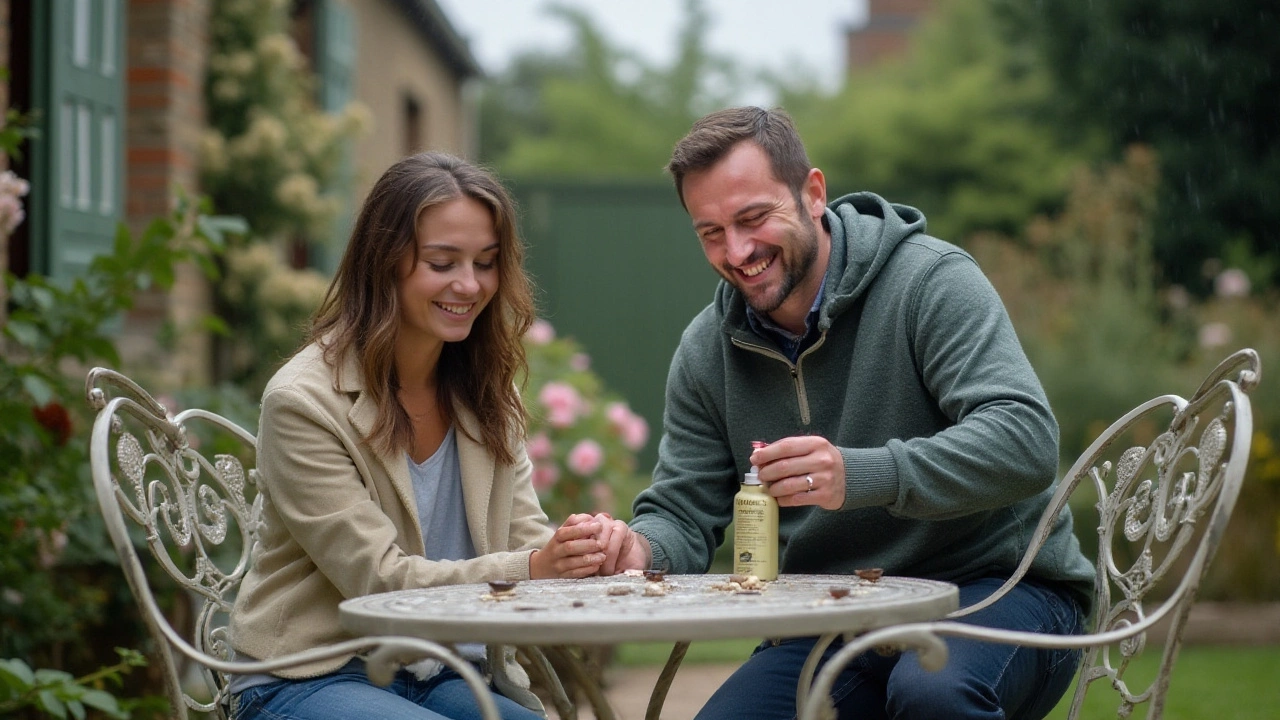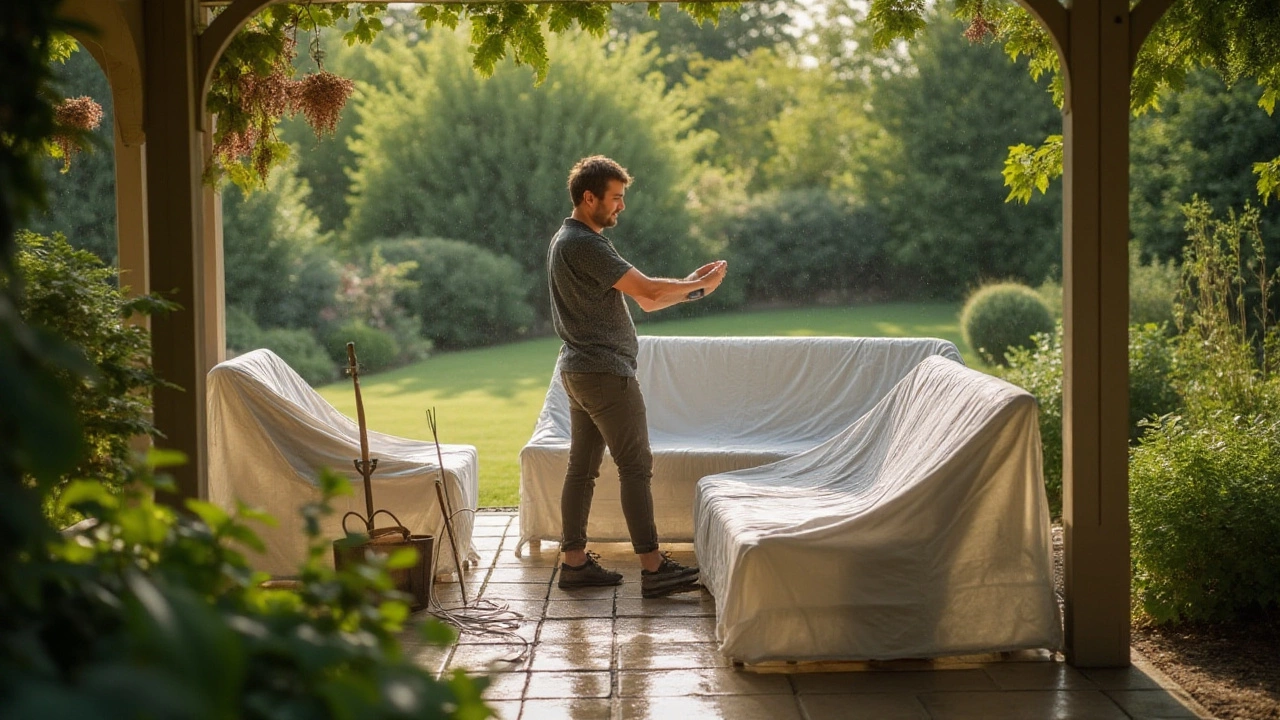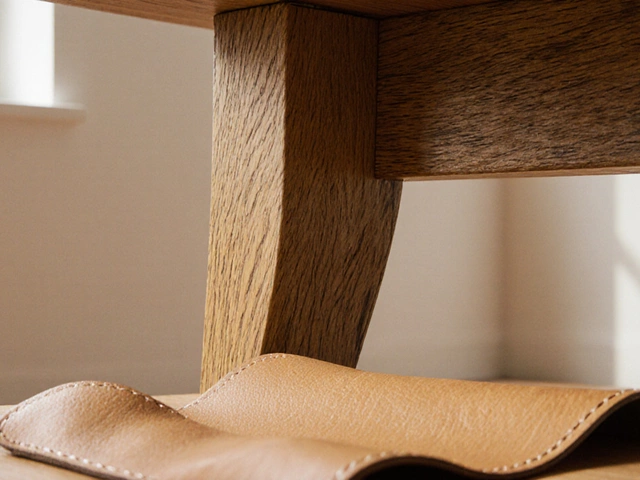Rain can be the greatest adversary for patio furniture, turning your outdoor oasis into a soggy predicament. Whether it's a sudden downpour or relentless drizzle, the elements pose a significant challenge to those who cherish their outdoor seating and tables.
To keep furniture unscathed and ready for sunny days, homeowners employ a variety of tactics. From hastily covering pieces with tarps to using custom-fit covers, there's no shortage of inventive approaches. Join us as we delve into these practices and uncover ways to keep your garden hangout in pristine condition, come rain or shine.
- Understanding Patio Furniture Needs
- Common Protective Measures
- Creative Storage Solutions
- Waterproofing Techniques
- Long-term Maintenance Tips
- Choosing the Right Covers
Understanding Patio Furniture Needs
Patio furniture, often the centerpiece of an outdoor haven, serves both functional and aesthetic purposes. It's essential to recognize the unique characteristics of different materials before you can effectively shield them from inclement weather. Patio furniture can be made from various materials, including wood, metal, wicker, and plastic, each with its challenges when it comes to durability and maintenance. While wooden pieces offer warmth and charm, they are particularly susceptible to water damage and require regular treatments with sealants to prevent warping or rotting.
Metal furnishings, on the other hand, are vulnerable to rust, especially if they've been scratched or weathered. Thus, it's crucial to inspect regular wear and tear to ward off oxidation. Many homeowners opt for aluminum due to its resistance to corrosion, making it a smarter choice for wetter regions. Wicker, whether it's synthetic or natural, demands particular care as well. While synthetic wicker is somewhat more resilient against the elements, natural wicker can quickly degrade if exposed to rain, needing consistent cleaning and protective coatings.
Understanding the specific needs of your garden furniture also means considering the local climate. Residents living in areas with heavy rainfalls might opt for easily movable furniture, allowing for quick relocation in times of need. Storage is another key factor; having a designated space such as a shed or garage ensures that when the skies spontaneously change, there's a secure spot to protect your precious investments.
According to a survey by the Outdoor Furniture Retailers Association, 64% of homeowners consider climate as their main factor when purchasing outdoor furniture.
Beyond the choice of materials, it's vital to consider the design and versatility of the furniture as well. Modular pieces offer the flexibility to reorganize or stack neatly for compact storage. This adaptability becomes a pivotal strategy in minimizing weather-related risks while maximizing the comfort and utility of your outdoor living area. By evaluating these elements, from materials and climate to design and storage, you can make informed decisions that not only enhance the longevity of your patio treasures but also amplify your outdoor enjoyment in the long run.
Common Protective Measures
When it comes to safeguarding your beloved patio furniture from the unpredictable weather, there are a myriad of strategies you can employ. Covering your furniture is often the first step, and many options are available that cater to different tastes and requirements. From waterproof covers available at garden centers to DIY solutions using tarps or old sheets, selecting the right kind of cover can provide the essential surface protection against rain and moisture damage. Over time, these elements can wear down even the most robust materials, so it's essential to think ahead and choose wisely.
Another effective method involves moving furniture under a shelter or awning. This might mean positioning them under a porch or beneath a purpose-built structure that complements the garden's aesthetics. Shelters provide another layer of protection by reducing the direct impact of rain, lessening the chance of pooling water that can ultimately lead to unsightly stains or mildew. This simple strategy can extend the life of outdoor pieces significantly, particularly during heavy or prolonged rainfall.
"An ounce of prevention is worth a pound of cure," as Benjamin Franklin wisely put it, and this rings true for garden enthusiasts keen on preserving their outdoor investments.
For those who prefer to maintain the rustic charm of wooden furniture, regular maintenance routines such as oiling and polishing with water-repellent products can be an invaluable line of defense. Keeping the surfaces treated and conditioned helps create a barrier against moisture penetration, thus slowing down the natural degradation process. While a bit labor-intensive, the payoff is a beautifully maintained patio set that serves you for years to come.
Communal seating areas can be transformed during the rainy season with additional accessories like high-quality cushions made from water-resistant fabrics. These add a splash of color while ensuring comfort, even when the sun peeks out after a shower. Still, these cushions should be stored indoors or in water-tight storage solutions when not in use to protect them further. Choosing wisely at purchase and integrating protective measures can help retain functionality and visual appeal.
In some cases, adopting a strategic approach by reconfiguring the layout of garden furniture in advance of adverse weather can also help. Position heavy pieces to anchor the lighter ones, reducing the risk of them being toppled or displaced. Developing a routine that involves rearranging your patio setup can become a weather-wise maneuver that contributes to the serenity and continuity of your outdoor experience. A dynamic and thoughtful method of adapting to the season's challenges can uphold the garden's charm while keeping damage at bay.

Creative Storage Solutions
When it comes to safeguarding patio furniture, sometimes you have to think outside the box—quite literally. In areas prone to unpredictable weather, clever storage solutions can save not only money but also preserve the cherished aesthetics of your outdoor oasis. If you've ever found yourself scrambling to protect your garden furniture from an impending rainstorm, consider some of these creative ideas that might just prevent your next panic. One popular approach is the use of multifunctional furniture pieces designed for outdoor use. These ingenious designs offer both utility and protection by incorporating storage within the furniture itself. For instance, benches with hidden compartments or tables with hollow bases provide space to stash cushions and covers whenever the clouds roll in. It's an efficient use of space and simplifies the task of keeping those soft furnishings dry and ready for use.
Another innovative option involves converting less-used indoor spaces into impromptu storage areas during the wetter months. Think of under-utilized garages, basements, or even sunrooms where furniture can be safely tucked away and shielded from harsh weather. Some homeowners even opt to invest in compact outdoor storage bins or sheds designed specifically to house patio accessories. While these options might require initial investment, the ease and longevity they afford are often well worth the expense. It's about finding what works best for your particular living arrangement while balancing cost and convenience.
There are also those who find charm and practicality in DIY storage solutions. Using reclaimed wood or weather-resistant materials, you can create custom storage benches or shelving units to fit your garden's aesthetics. A thick coat of weatherproof paint can ensure these solutions withstand the elements, adding both function and flair to your outdoor space. Interestingly, repurposing old items such as barrels or crates into storage units not only gives them new life but can also enhance the rustic appeal of your garden setup, perfectly blending utility with design.
"Protecting your patio from the elements is not just about coverage, it's about creativity," shares garden design expert Jamie Butterworth. Indeed, finding ways to make storage a design feature offers a winning combination of function and style. Embracing such creativity not only safeguards your investment but can turn functional needs into statements of style.
Lastly, communal storage solutions for smaller spaces or apartment dwellers shouldn't be overlooked. If you share green space with neighbors, consider renting nearby storage units as a collective investment. This approach allows for shared expenses and resources while fostering a sense of community around the maintenance of your outdoor areas. A small monthly fee can unlock peace of mind, knowing your treasured garden furniture is securely stored, ready to emerge unscathed as soon as the sun reappears.
Waterproofing Techniques
When it comes to keeping your patio furniture safe from the rain, waterproofing is a tried and true method that many homeowners turn to. One of the simplest techniques involves using sealants. These are specially designed to create an invisible, protective layer over the furniture's surface. You can find sealants in various forms, from sprays to liquid applications, making them incredibly versatile. Applying a sealant is usually straightforward, yet it requires patience and a bit of elbow grease to do correctly. Always start by ensuring your furniture is clean and dry, as any dirt or moisture can compromise the sealant's effectiveness.
An often overlooked factor is attention to seams and joints, where water is most likely to infiltrate. Pay special care by applying extra sealant to these areas. For those dealing with wooden furniture, specialist products like teak oil add not just protection but also enhance the natural beauty of the wood. Metals, especially iron and steel, may benefit from rust-proof paints that serve a dual purpose of aesthetics and protection. It’s interesting how much value these products add by ensuring the longevity of your cherished outdoor pieces.
Alternatively, some more advanced techniques involve using waxes and varnishes. While these might require more frequent reapplication compared to sealants, they often offer better water resistance. Bear in mind, that waxing furniture can be time consuming, as you need to allow each layer to fully set before applying the next. However, the results can be extremely satisfying, providing a natural gloss that also acts as a shield against the elements. If you are looking for the most effective solution, a combination of these methods might be perfect, ensuring a comprehensive approach to waterproofing.
Both DIY enthusiasts and professionals sometimes turn to a trick from the automotive world: using a product called hydrophobic spray, frequently used on car windshields to repel water. When applied correctly to garden furniture, these sprays can create a long-lasting barrier that makes water simply roll off the surface. This innovative solution is gaining popularity, as it's straightforward to use and doesn't require constant touch-ups.
| Product Type | Application Frequency | Cost Range |
|---|---|---|
| Sealant | Every 6-12 months | £15 - £30 |
| Teak Oil | Every 3-6 months | £10 - £25 |
| Hydrophobic Spray | Annually | £20 - £40 |
Lastly, it’s crucial to not forget that consistent maintenance remains key. Regular inspections, cleaning, and timely reapplications of protective coatings extend the life of the treatments significantly. Many say that 'prevention is better than cure,' which might sound cliché but rings true when it comes to outdoor furniture care. Thus, taking these rain protection steps is not merely about safeguarding your investment but also about keeping your patio a delightful space for any occasion.

Long-term Maintenance Tips
Investing in patio furniture is not just about improving the aesthetic appeal of outdoor spaces; it's also about enhancing the functionality and longevity of these pieces. Regular maintenance is key to ensuring that your garden furniture stands the test of time, particularly in climates that experience frequent rain. One of the first steps in long-term care is to know what material your furniture is made of. Different materials require different maintenance regimens. For wood, periodic sealing and oiling are essential to prevent moisture damage, while metal furniture might benefit more from a coat of protective wax to ward off rust.
A strategic approach to outdoor furniture maintenance also involves seasonal planning. Before the rainy season sets in, conduct a thorough inspection of your pieces. Look for signs of wear and tear, such as cracks in wooden parts or peeling paint on metal surfaces. Such minor damage, if left unattended, can become exacerbated by rain, leading to expensive repairs or replacements. An interesting stat from a 2022 study revealed that over 60% of property owners who routinely inspected their outdoor furniture reported fewer instances of severe damage over a five-year period, suggesting the power of a proactive approach.
Storage plays a pivotal role in maintaining the pristine condition of your patio set. Storing your furniture in a dry and covered space during prolonged periods of rain can significantly extend its life. If indoor storage isn't feasible, high-quality rain protection covers serve as a decent alternative. Choose covers made of breathable materials to prevent mold and mildew. A helpful tip for long-term storage is to slightly elevate furniture to prevent direct contact with the ground, reducing the risk of moisture absorption. According to Jane Smith, a garden expert from 'Outdoor Living Magazine':
"Elevating your wooden patio furniture even by an inch can improve air circulation, thus preventing water pooling around the legs, which is often the first point of damage."
Routine cleaning is not to be underestimated when it comes to garden furniture. Dust and grime accumulations can quickly tarnish even the most robust materials. Depending on the type of material, cleaning methods will vary. For instance, regularly wiping down metal furniture with a damp cloth will help maintain its sheen, and applying a rust-resistant primer can ensure metal surfaces remain unblemished. For plastic or resin furniture, a simple mixture of water and mild detergent can work wonders without labor-intensive scrubbing. Establish a cleaning schedule throughout the wetter months, as moisture combined with dirt can lead to discoloration. Such consistent efforts at cleaning and maintenance will not only preserve your furniture's appearance but also its integrity, keeping it a staple part of your home for many rainy seasons to come.
Choosing the Right Covers
When it rains, having the right covers for your patio furniture can be the distinguishing factor between a quick dry-off and days of waiting for the sun to work its magic. Selecting these covers involves more than simply picking the first option that fits. It's a blend of ensuring the cover fits well, is made from durable, waterproof materials, and can be easily handled or stored when not in use.
Start by considering the material of the cover. Look for options crafted from heavy-duty polyester or vinyl, both known for their durability and waterproof attributes. These materials often come with ultra-violet (UV) protection to minimize sun damage once the clouds clear. While it might seem counterintuitive to worry about the sun during a rainy discussion, UV damage remains one of the chief culprits for wear and tear of outdoor gear.
An essential feature in selecting these covers is breathability. Choose covers with ventilation flaps that reduce moisture buildup underneath. This prevents mold and mildew, keeping your furniture fresh and inviting. In the words of renowned terrace designer, John Ellickson, "Good outdoor covers act like wearable raincoats; they don't just shield from rain but also let the skin breathe." This approach ensures your investment stays protected, without trapping damaging moisture beneath.
Size and fit play pivotal roles too. Always measure your furniture precisely before purchasing a cover. Opt for covers that provide a snug fit but remember to have some room for air circulation. Adjustable cords or straps can often help secure the cover during gusty winds.
Ease of use is another facet to address. Opting for covers that are lightweight yet sturdy, with easy-to-use securing mechanisms, can simplify the process of getting them on and off with minimal hassle. It may seem like a minor detail, but during inclement weather, an easy-to-handle cover is a blessing. Brands that offer handles or tags for clear orientation help in swiftly covering the furniture when clouds start rolling in.
Many homeowners are now choosing custom covers tailored to their garden furniture. Although pricier, these offer the best defense against inconsistent weather patterns and environmental elements, giving peace of mind any day, rain or shine. Investing in these can save you not only money over time but also the effort of cleaning and maintaining your beloved lounging spots. Should you decide to splurge, view it as a long-term enhancement to your outdoor lifestyle.
If you're wavering between options, consulting reviews or reaching out to fellow patio enthusiasts can provide crucial insights. Many garden store websites provide sections devoted to real-life usage accounts, adding a layer of authenticity before you commit. Rain protection is an investment, and taking these steps ensures your furniture will withstand the elements while you continue enjoying your outdoor space.



